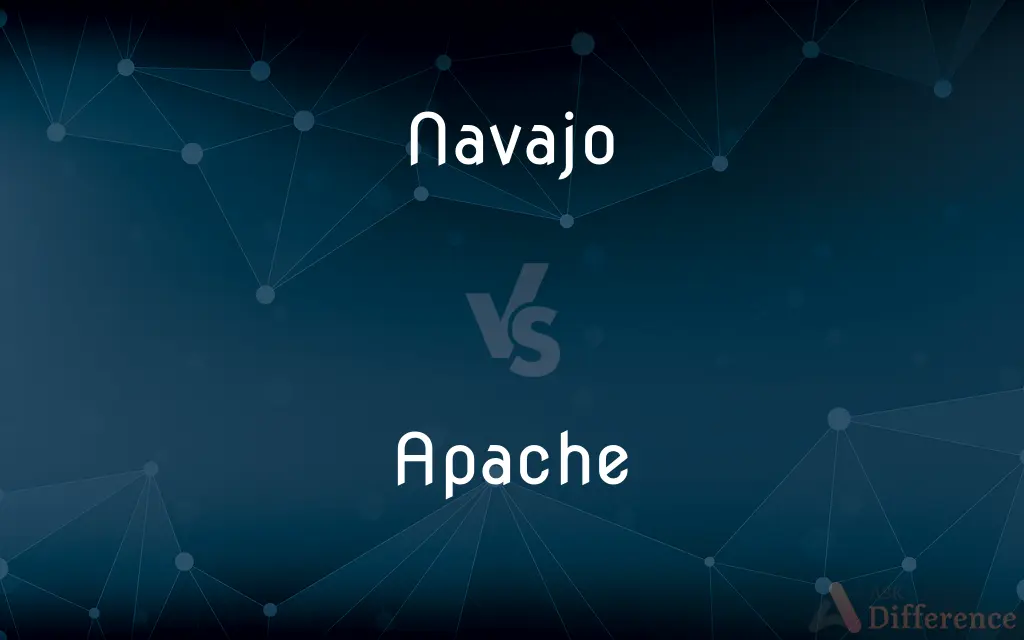Navajo vs. Apache — What's the Difference?
By Tayyaba Rehman & Urooj Arif — Updated on March 27, 2024
Navajo and Apache are both Native American peoples with shared Athabaskan linguistic roots, but they differ significantly in their historical territories, cultures, and lifestyles.

Difference Between Navajo and Apache
Table of Contents
ADVERTISEMENT
Key Differences
The Navajo people primarily inhabit the southwestern United States, especially the Navajo Nation, which spans parts of Arizona, New Mexico, and Utah. This region is characterized by its vast desert landscapes and significant cultural sites. In contrast, the Apache tribes historically roamed a wider range of territories, including parts of modern-day Texas, New Mexico, Arizona, and Oklahoma, known for their nomadic and warrior traditions.
Culturally, the Navajo are renowned for their intricate weaving, silverwork, and sandpainting, reflecting a deep connection to their environment and spirituality. Apache cultures, while diverse across different groups, are celebrated for their basketry, beadwork, and skills in guerrilla warfare, emphasizing resilience and adaptability.
Socially, Navajo society is matrilineal, placing significant importance on the role of women in lineage and inheritance. Apache societies also exhibit matrilineal traits but are particularly noted for their emphasis on kinship ties and communal living, alongside their prowess in battle and strategy.
Economically, the Navajo have a strong tradition of sheep herding, agriculture, and arts and crafts, which play a crucial role in their economy. The Apache, historically known as fierce hunters and gatherers, adapted over time to include raiding and trading as part of their economic activities.
In terms of governance, the Navajo Nation operates the largest tribal government in the U.S., with a complex system that integrates traditional leadership with modern administrative structures. Apache tribes, including the Chiricahua, Mescalero, and others, have their own distinct governments, often focusing on preserving cultural heritage and autonomy.
ADVERTISEMENT
Comparison Chart
Location
Arizona, New Mexico, Utah
Texas, New Mexico, Arizona, Oklahoma
Cultural Traits
Weaving, silverwork, sandpainting
Basketry, beadwork, guerrilla warfare
Society
Matrilineal, importance of women
Kinship ties, communal living
Economy
Sheep herding, agriculture, crafts
Hunting, gathering, raiding, trading
Governance
Large tribal government
Distinct tribal governments
Compare with Definitions
Navajo
Renowned for weaving.
Navajo rugs are famous for their intricate designs and craftsmanship.
Apache
Known for mobility.
Apache tribes were highly mobile, skilled in horseback riding.
Navajo
Largest Native American reservation.
The Navajo Nation is the largest reservation in the U.S.
Apache
Basketry and beadwork.
Apache crafts include intricate basketry and beadwork.
Navajo
Sheep herding culture.
Sheep play a central role in Navajo society and economy.
Apache
Strong kinship ties.
Apache society emphasizes strong familial and communal bonds.
Navajo
Matrilineal society.
Navajo inheritance and descent are traced through the mother's line.
Apache
Diverse tribal groups.
Apache includes groups like the Chiricahua and Mescalero.
Navajo
Sandpainting rituals.
Navajo sandpaintings are used in healing ceremonies.
Apache
Guerrilla warfare tactics.
Apaches used guerrilla tactics effectively against adversaries.
Navajo
The Navajo (; British English: Navaho; Navajo: Diné or Naabeehó) are a Native American people of the Southwestern United States. At more than 399,494 enrolled tribal members as of 2021, the Navajo Nation is the largest federally recognized tribe in the U.S. (the Cherokee Nation being the second largest); the Navajo Nation has the largest reservation in the country.
Apache
The Apache () are a group of culturally related Native American tribes in the Southwestern United States, which include the Chiricahua, Jicarilla, Lipan, Mescalero, Mimbreño, Ndendahe (Bedonkohe or Mogollon and Nednhi or Carrizaleño and Janero), Salinero, Plains (Kataka or Semat or "Kiowa-Apache") and Western Apache (Aravaipa, Pinaleño, Coyotero, Tonto). Distant cousins of the Apache are the Navajo, with whom they share the Southern Athabaskan languages.
Navajo
A member of a Native American people inhabiting extensive reservation lands in Arizona, New Mexico, and southeast Utah. The most populous of contemporary Native American groups in the United States, the Navajo are noted as stockbreeders and skilled weavers, potters, and silversmiths.
Apache
A member of a Native American people inhabiting the southwest United States and northern Mexico. Various Apache tribes offered strong resistance to encroachment on their territory in the latter half of the 19th century. Present-day Apache populations are located in Arizona, New Mexico, and Oklahoma.
Navajo
The Apachean language of the Navajo.
Apache
Any of the Apachean languages of the Apache.
Navajo
A member of an Athapaskan people that migrated to Arizona and New Mexico and Utah
Apache
A member of the Parisian underworld.
Navajo
The Athapaskan language spoken by the Navaho people
Apache
Alternative case form of Apache, a Parisian gangster.
Apache
Any member of Athapaskan tribes that migrated to the southwestern desert (from Arizona to Texas and south into Mexico); fought a losing battle from 1861 to 1886 with the United States and were resettled in Oklahoma
Apache
A Parisian gangster
Apache
The language of the Apache people
Common Curiosities
What are significant ceremonies for Navajo and Apache peoples?
The Navajo conduct elaborate healing ceremonies like the Nightway, while Apache ceremonies often include rites of passage and healing rituals.
How have Navajo and Apache societies adapted to modern challenges?
Both have integrated traditional ways with contemporary governance and economies, focusing on cultural preservation and self-sufficiency.
How do Navajo and Apache peoples participate in U.S. politics?
They engage through their sovereign tribal governments, advocacy, and participation in state and federal politics to protect their rights and lands.
What language do Navajo and Apache speak?
Both speak languages from the Athabaskan family, with distinct dialects for each group.
What is the significance of land to Navajo and Apache peoples?
Land is central to their cultural identity, spirituality, and livelihoods, with sacred sites and resources crucial to their traditions and survival.
Can individuals from Navajo and Apache cultures easily understand each other's languages?
While there are linguistic similarities, the languages are distinct enough to require learning to communicate fluently across groups.
How do Navajo and Apache cultures reflect their environments?
Navajo art and crafts are deeply influenced by desert landscapes, while Apache lifestyles were adapted to diverse terrains, from deserts to mountains.
What role do women play in Navajo and Apache societies?
In both societies, women hold significant roles, with the Navajo emphasizing matrilineal descent and Apache valuing kinship and familial responsibilities.
What are traditional foods for Navajo and Apache peoples?
Navajo traditional foods include corn, squash, and mutton, while Apache diets historically consisted of game, wild plants, and cultivated crops.
How do Navajo and Apache peoples preserve their cultural heritage?
Through education, ceremonies, language revitalization programs, and museums, they actively preserve and pass down their traditions.
Share Your Discovery

Previous Comparison
Avena vs. Oat
Next Comparison
Beneficiary vs. PayeeAuthor Spotlight
Written by
Tayyaba RehmanTayyaba Rehman is a distinguished writer, currently serving as a primary contributor to askdifference.com. As a researcher in semantics and etymology, Tayyaba's passion for the complexity of languages and their distinctions has found a perfect home on the platform. Tayyaba delves into the intricacies of language, distinguishing between commonly confused words and phrases, thereby providing clarity for readers worldwide.
Co-written by
Urooj ArifUrooj is a skilled content writer at Ask Difference, known for her exceptional ability to simplify complex topics into engaging and informative content. With a passion for research and a flair for clear, concise writing, she consistently delivers articles that resonate with our diverse audience.
















































